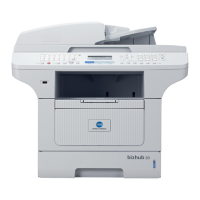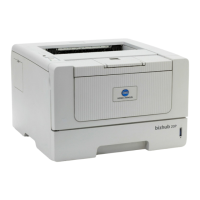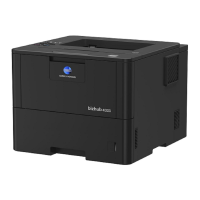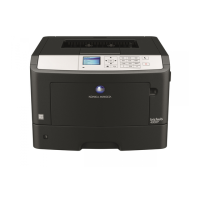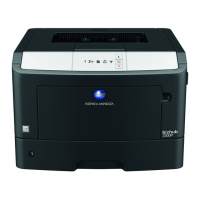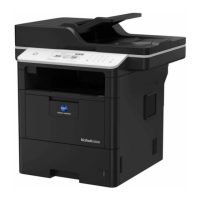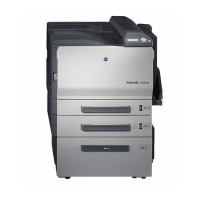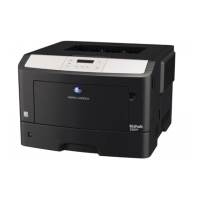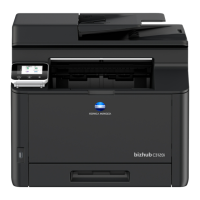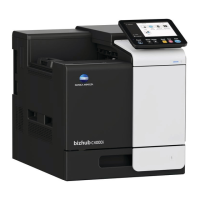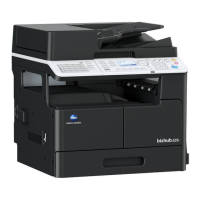
Do you have a question about the Konica Minolta bizhub 225i and is the answer not in the manual?
| Print Speed | 22 ppm |
|---|---|
| Print Resolution | 600 x 600 dpi |
| Duplex Printing | Yes |
| Max Paper Capacity | 1, 350 sheets |
| Type | Monochrome Multifunction Printer |
| Copy Speed | 22 cpm |
| Copy Resolution | 600 x 600 dpi |
| Scan Resolution | 600 x 600 dpi |
| Paper Size | A3, A4, A5, B4, B5 |
| Connectivity | USB 2.0, Ethernet |
| Fax Resolution | 600 x 600 dpi |
| Warm-Up Time | Approx. 15 seconds |
| Weight | Approx. 28 kg |
Provides a greeting and overview of the user's guide content.
Explains notations, symbols, and procedural instructions for understanding the manual.
Details how original and paper sizes are indicated within the manual.
Details the names and functions of the machine's control panel and optional extended panel.
Explains how to use the ADF, original types, and provides cautions for loading documents.
Guides through essential initial setup steps like date, time registration, and default settings check.
Outlines the essential steps for sending a fax, from loading originals to initiating transmission.
Details methods for loading originals into the ADF and onto the Original Glass for scanning.
Explains how to select image quality settings for optimal fax clarity based on the original.
Covers methods to specify a fax destination, including direct entry, speed dial, and address book.
Describes actions to take when the machine's memory becomes full during scanning or transmission.
Explains the machine's automatic redialing process and how transmission failures are handled.
Guides on performing fax transmission manually after a phone conversation with the recipient.
Explains how to cancel an ongoing fax transmission or a reserved transmission job.
Details how to check communication results and print various reports or lists for transmission history.
Lists and describes the different types of reports and lists available for fax communication.
Explains the differences and usage of memory transmission versus immediate transmission.
Guides on setting a specific time for fax transmission, often for cost savings.
Explains how to schedule and send multiple originals stored in memory at a predetermined time.
Covers memory receiving, paper size handling, paper priority, and automatic/manual reception methods.
Explains how to use the machine's telephone function to make outgoing calls.
Explains how to receive incoming phone calls when the machine is connected to an external phone.
Details how to use F-Code for secure and confidential fax transmission.
Explains how to use confidential user boxes for secure fax data transfer and reception.
Guides on sending documents based on a receiver's polling request via a confidential user box.
Explains how to receive documents when the sender initiates the request using polling.
Details how to send an original to a relay station for broadcasting to multiple destinations.
Explains how the machine can act as a relay station to receive and forward to multiple destinations.
Describes how to forward received fax documents to another fax number or email address.
Covers the configuration and procedure for sending faxes using the Internet Fax function.
Details settings like transmission time, size, resolution, and compression for Internet Fax.
Explains how to set image quality and density for scanning originals for Internet Fax transmission.
Covers specifying titles and forward destinations for enhancing Internet Fax operations.
Details configuration and procedures for automatically or manually receiving Internet faxes.
Introduces the PC-FAX function, how it works, and its operating environment requirements.
Provides step-by-step instructions for installing the PC-FAX driver via USB or network connection.
Guides on creating documents and sending faxes from a PC using the installed PC-FAX driver.
Covers basic settings, sender information, and address book management for the fax driver.
Explains various utility settings for machine management, including admin settings and copy configurations.
Details how to register and manage destinations in one-touch dial, speed dial, and group dial.
Covers registration of confidential user boxes and relay user boxes for secure fax operations and relay distribution.
Explains settings for scanning density, quality priority, default TX mode, and header printing for transmissions.
Details settings for memory RX, number of rings, reduction, RX print, RX mode, and forward mode for receptions.
Guides on configuring automatic printing of activity, reservation, and transmission/reception reports.
Introduces the Web Connection utility for remote machine control via a web browser.
Explains how to access the utility and navigate its interface, including user and administrator modes.
Describes using the menu items in user mode for checking machine status and settings via Web Connection.
Lists common error messages and provides corrective actions for various machine issues like paper jams and memory errors.
Provides solutions for common issues encountered when sending faxes, such as original scanning problems.
Offers solutions for common issues encountered when receiving faxes, like unclear images or reception failures.
Addresses common problems related to sound, tones, and volume when using the machine's phone features.
Lists technical specifications for the fax function, including transmission modes, baud rates, and paper sizes.
Explains what LSU is, its functions, operating environment, and setup procedures.
Defines key terms used throughout the manual related to fax communication and machine operation.
An alphabetical listing of manual topics and their corresponding page numbers for quick reference.
An alphabetical listing of machine buttons/controls and their related page numbers for quick reference.
